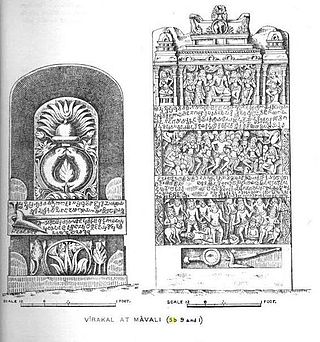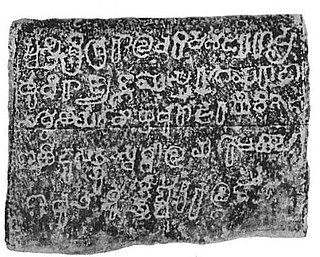
Amoghavarsha I was the greatest emperor of the Rashtrakuta dynasty, and one of the most notable monarchs of Ancient India. His reign of 64 years is one of the longest precisely dated monarchical reigns on record. Many Kannada and Sanskrit scholars prospered during his rule, including the great Indian mathematician Mahaviracharya who wrote Ganita-sara-samgraha, Jinasena, Virasena, Shakatayan and Sri Vijaya.

Rashtrakuta was a royal Indian dynasty ruling large parts of the Indian subcontinent between the 6th and 10th centuries. The earliest known Rashtrakuta inscription is a 7th-century copper plate grant detailing their rule from Manapur, a city in Central or West India. Other ruling Rashtrakuta clans from the same period mentioned in inscriptions were the kings of Achalapur and the rulers of Kannauj. Several controversies exist regarding the origin of these early Rashtrakutas, their native homeland and their language.
Govinda II also known as Govindaraja was the Rashtrakuta emperor who succeeded his father Krishna I.

Govinda III was greatest Rashtrakuta monarch who succeeded his illustrious father Dhruva Dharavarsha. He was militarily the most successful emperor of the dynasty with successful conquests from Kanyakumari in the south to Kanyakubja in the north, from Banaras in the east to Bharuch in the west. From the Someshvara inscription of 804, it is known that 'Gamundabbe' was his chief queen.

Western Ganga was an important ruling dynasty of ancient Karnataka in India which lasted from about 350 to 1000 CE. They are known as "Western Gangas" to distinguish them from the Eastern Gangas who in later centuries ruled over Kalinga. The general belief is that the Western Gangas began their rule during a time when multiple native clans asserted their freedom due to the weakening of the Pallava empire in South India, a geo-political event sometimes attributed to the southern conquests of Samudra Gupta. The Western Ganga sovereignty lasted from about 350 to 550 CE, initially ruling from Kolar and later, moving their capital to Talakadu on the banks of the Kaveri River in modern Mysore district.

Kavirajamarga is the earliest available work on rhetoric, poetics and grammar in the Kannada language. It was inspired by or written in part by the famous Rashtrakuta King Amoghavarsha I, and some historians claim it is based partly on the Sanskrit text Kavyadarsha. Some historians believe Kavirajamarga may have been co-authored by a poet in the king's court, the Kannada language theorist Sri Vijaya.

Dhruva was one of the most notable rulers of the Rashtrakuta Empire. He ascended the imperial throne after replacing his elder brother Govinda II. Govinda II had become unpopular among his subjects on account of his various misconducts as a monarch, including excessive indulgence in sensual pleasures. This according to the historian Kamath is evident from the Karhad plates of Krishna III. The Dhulia grant of 779 and Garugadahalli inscription of 782 proclaim Dhruva the emperor. Though some historians claim that Dhruva revolted and grabbed the throne, other historians feel the transition of the throne from Govinda II to Dhruva was peaceful and may have happened willingly. He earned titles like Kalivallabha, Srivallabha, Dharavarsha, Maharajadhiraja and Parameshvara.

Krishna I, an uncle of Dantidurga, took charge of the growing Rashtrakuta Empire by defeating the last Badami Chalukya emperor Kirtivarman II in 757. This is known from the copper plate grant of Emperor Govinda III of 807 and a copper plate grant of the Gujarat Rashtrakuta ruler Karka from Baroda. He is also known as Kannara or Kannesvara and took the titles Akalavarsha, Shubatunga, Prithvivallabha and Shrivallabha. He patronised the famous Jain logician Akalanka Bhatta, the author of Rajavartika.
Krishna II ascended the Rashtrakuta throne after the demise of his famous father Amoghavarsha I Nrupatunga. His Kannada name was Kannara. His queen was a Haihaya princess of Chedi called Mahadevi. From the chronology of inscriptions that mention the name of this king, it seems Krishna II may have started to rule even during the lifetime of his father. The fact that Amoghavarsha in his last years renounced the affairs of the state in religious pursuits supports this claim. The rule of Krishna II saw significant advances in literature, although in the affairs of expansion of the empire, his reign was mixed. During his reign he cultivated matrimonial alliance with Chedis to form military gain.
Indra III was the grandson of Rashtrakuta Krishna II and son of Chedi princess Lakshmi. He became the ruler of the empire due to the early demise of his father Jagattunga. He had many titles such as Nithyavarsha, Rattakandarapa, Rajamarathanda and Kirthinarayana. He patronised Kannada poet and commander SriVijaya and Sanskrit poet Trivikrama. Indra III was married to princess Vijamba of the Kalachuri dynasty of central India (Chedi).
Govinda IV was the younger brother of Amoghavarsha II. He became the Rashtrakuta emperor in 930 as described in the Kalasa record of Chikmagalur. He was a very unpopular ruler who indulged in licentious acts. Control over Kannauj was lost during his rule. The Chalukyas of Vengi defeated him and much territory was lost. Finally, his own feudatories including King Arikesari of Vemulavada revolted against him and placed Amoghavarsha III on the throne in 935. This is known from the records of Kannada poet Adikavi Pampa, who was patronised by King Arikesari. Govinda IV had matrimonial relationship with the Cholas of Kanchi and finally found refuge with them when his feudatories revolted. Govinda IV patronised Kannada poet Ravinagabhatta.
Amoghavarsha III, whose Kannada name was Baddega, was in exile in Tripuri and was a younger brother of Indra III and uncle to Govinda IV. He came to power with the help of feudatory King Arikesari of Vemulavada in Andhra and other vassals who revolted against Govinda IV. Not much is known about his uneventful reign. His advanced age and religious temperament did not allow him to show any interest in the governance of the empire which was left to his son Krishna III. He was married to Kundakadevi, a princess from the Kalachuri dynasty of Tripuri. His daughter was married to Western Ganga King Butuga II to whom a large territory was given as dowry.

Krishna III whose Kannada name was Kannara was the last great warrior and able monarch of the Rashtrakuta dynasty of Manyakheta. He was a shrewd administrator and skillful military campaigner. He waged many wars to bring back the glory of the Rashtrakutas and played an important role in rebuilding the Rashtrakuta empire. He patronised the famous Kannada poets Sri Ponna, who wrote Shanti purana, Gajankusha, also known as Narayana, who wrote on erotics, and the Apabhramsha poet Pushpadanta who wrote Mahapurana and other works. His queen was a Chedi princess and his daughter Bijjabbe was married to a Western Ganga prince. During his rule he held titles such as Akalavarsha, Maharajadhiraja, Parameshvara, Paramamaheshvara, Shri Prithvivallabha etc. At his peak, he ruled a vast empire stretching from the Narmada river in the north to the Kaveri river delta in the south. A copper grant of 993 issued by the Shilahara king of Thana claims the Rashtrakuta control extended from the Himalayas in the north to Ceylon in the south and from the eastern sea to the western seas. The grant states that when King Krishna III mobilised his armies, the kings of Chola, Bengal, Kannauj, Andhra and Pandya regions used to quiver.
Shivamara II was the son of Sripurusha and ruled the Western Ganga Dynasty from 788 – 816 C.E. He was also a noted scholar in Kannada, Sanskrit and Prakrit. He succeeded to the Ganga throne during a time when the Rashtrakuta were the empire on the rise in South India and the Deccan.
Butuga II became the ruler of the Western Ganga Dynasty after his elder brother Rachamalla III.

Rashtrakuta literature is the body of work created during the rule of the Rastrakutas of Manyakheta, a dynasty that ruled the southern and central parts of the Deccan, India between the 8th and 10th centuries. The period of their rule was an important time in the history of South Indian literature in general and Kannada literature in particular. This era was practically the end of classical Prakrit and Sanskrit writings when a whole wealth of topics were available to be written in Kannada. Some of Kannada's most famous poets graced the courts of the Rashtrakuta kings. Court poets and royalty created eminent works in Kannada and Sanskrit, that spanned such literary forms as prose, poetry, rhetoric, epics and grammar. Famous scholars even wrote on secular subjects such as mathematics. Rashtrakuta inscriptions were also written in expressive and poetic Kannada and Sanskrit, rather than plain documentary prose.

The political history of medieval Karnataka spans the 4th to the 16th centuries, when the empires that evolved in the Karnataka region of India made a lasting impact on the subcontinent. Before this, alien empires held sway over the region, and the nucleus of power was outside modern Karnataka. The medieval era can be broadly divided into several periods: The earliest native kingdoms and imperialism; the successful domination of the Gangetic plains in northern India and rivalry with the empires of Tamilakam over the Vengi region; and the domination of the southern Deccan and consolidation against Muslim invasion. The origins of the rise of the Karnataka region as an independent power date back to the fourth-century birth of the Kadamba Dynasty of Banavasi, the earliest of the native rulers to conduct administration in the native language of Kannada in addition to the official Sanskrit. This is the historical starting point in studying the development of the region as an enduring geopolitical entity and of Kannada as an important regional language.
Several Branches of the Rashtrakuta dynasty were created by the kings, commanders and relatives of the Rashtrakuta family during their expansion into central and northern India in the eighth to the tenth centuries. These kingdoms ruled during the reign of the parent empire or continued to rule for centuries after its fall or came to power much later. Well known among these were the Rashtrakutas of Gujarat (757-888), the Rattas of Saundatti (875-1230) in modern Karnataka, the Rashtrakutas of Rajasthan and ruling from Hastikundi or Hathundi (893-996), Dahal, the Rathores of Mandore and Dhanop, Reddy dynasty of Andhra Pradesh and Telangana, Rashtraudha dynasty of Mayuragiri in modern Maharashtra and Rashtrakutas of Kanauj.
Arikesari II was a ruler of the Vemulavada Chalukya dynasty of present-day Telangana, India. A Rashtrakuta vassal, he played an important role in dethroning the Rashtrakuta emperor Govinda IV and enthroning Amoghavarsha III as the new emperor. He was the patron of Pampa, one of the earliest notable Kannada-language poets.
The Ayudha dynasty was the short-lived, second dynasty of the Kannauj State from the late 8th to the early 9th century CE.








